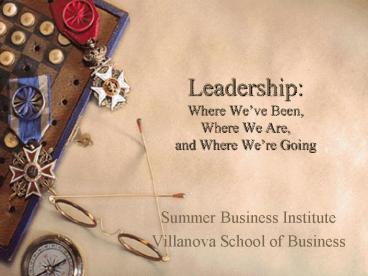Leadership: Where Weve Been, Where We Are, and Where Were Going - PowerPoint PPT Presentation
Title:
Leadership: Where Weve Been, Where We Are, and Where Were Going
Description:
Very generally, leadership can be viewed as a social influence process ... Mr. Slate (the boss from The Flintstones), Saddam Hussein, John Wayne characters. ... – PowerPoint PPT presentation
Number of Views:72
Avg rating:3.0/5.0
Title: Leadership: Where Weve Been, Where We Are, and Where Were Going
1
Leadership Where Weve Been, Where We Are,
and Where Were Going
- Summer Business Institute
- Villanova School of Business
2
Overview
- Definition of leadership
- Brief history of the study of leadership
- Trait approach
- Behavioral approach
- Leadership style approach
- A useful style paradigm
- Other leadership issues
- The future of leadership
3
Definition of Leadership
- Roots of word lead
- Ancient Norse term laed
- To determine the course of a ship
- Very generally, leadership can be viewed as a
social influence process - The holy grail of leadership research
- What makes a leader effective?
4
Brief History Trait Approach
- Emphasis on personal attributes of leaders
- Stable individual dispositions
- Could include personality, temperament, needs,
motives, and values - Examples self-confidence, emotional stability,
stress tolerance, energy level, integrity, need
for power - Hundreds of traits studies conducted in 1930s and
1940s no conclusive findings! - Issues lack of theory and overly simplistic
approach - Other issues?
5
Brief History Behavioral Approach
- Breakthrough 1950s and 1960s at The Ohio State
University and University of Michigan - Lists of behaviors created
- Statistical analysis two broad categories of
behaviors - Consideration/relations-oriented behavior
(concern for people) - Initiating structure/task-oriented behavior
(concern for task)
6
Brief History Style Approach
- An immediate outgrowth of the behavioral and
contingency approaches to leadership - Autocratic emphasize task over people
- Laissez-faire little concern for the task
- Democratic committed to task and people
7
Manz and Sims
- Directive-- autocratic, dictatorial, fear and
intimidation frequently used, top-down
communication, etc. Can be useful in situations
of high-stress, where quick decisions are
necessary (e.g., military, some sports teams,
etc.). Examples Mr. Slate (the boss from The
Flintstones), Saddam Hussein, John Wayne
characters. - Transactional-- relationships between leaders and
followers are exchange-oriented. Leaders reward
followers when they do well (either verbally or
with actual rewards like performance bonuses),
and punish employees when they don't. Can be
useful in organizations (e.g., sales commissions
for employees). Example parents giving
allowances to their kids for performing chores. - Transformational--charismatic, value-based
leadership. A set of core values is the
cornerstone the leader also puts forth an
envisioned future that gets everyone very
emotionally invested in the vision. Can be really
useful when change is necessary. Examples Martin
Luther King, Ghandi. Issue The Dark Side--
followers get too wrapped up emotionally in this,
may become less able to think for themselves.
Hitler is another example of a classic
transformational leader. - Empowering--leader's focus is on developing
followers to be able to lead themselves. So,
ultimately, the leader can leave the situation
and followers are well-prepared to take over.
Example Herb Kelleher of Southwest Airlines.
Into power-sharing and distribution of
responsibility and authority. Also into autonomy
and allowing employees to make own decisions. Can
be really useful in all kinds of situations--
encourages innovation, prepares individuals for
life. Also a really good parenting style!
8
Other Considerations in the Leadership Literature
- Emotional intelligence more important at higher
levels self-awareness self-regulation
motivation empathy social skill - Gender and leadership women tend to be more
participative, motivational, better
communicators, listeners, respectful, care for
others, share info - Change leadership taking leadership
responsibility for changing the existing pattern
of behavior of another person or social system
willingness to take risks seizes opportunity
expects surprise makes things happen promotes
and actively supports creativity and innovation - Change strategies
- force-coercion uses rewards and punishments as
the primary inducements to change - Rational persuasion bring about change through
persuasion backed by special knowledge, data, and
rational argument - Shared power engages people in a collaborative
process of identifying values, assumptions, and
goals from which support for change will
naturally emerge most time consuming but more
often results in longer lasting commitments to
the change
9
The Future of Leadership YOU!
- To be an effective leader
- Know yourselfyour world view, your assumptions,
your choices and options - Stay in touch with reality try to be objective
- Set attainable goals and standards for yourself
know who you are and what you are about - Other ideas?
10
Learning Points
- Know background on why leadership is studied,
evolution of leadership research - Know about other issues in leadership research
- Think about what kind of leader YOU aspire to be!
11
Leaders are best When people barely know they
exist, Not so good when people obey and acclaim
them, Worse when they are despised. But of good
leaders, who talk little, When their work is
done, their aim fulfilled, The people will
say We did it ourselves. --Lao Tzu































